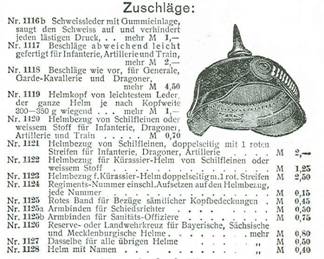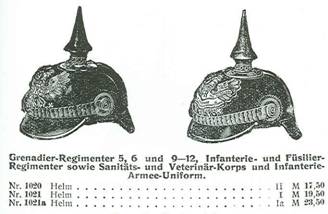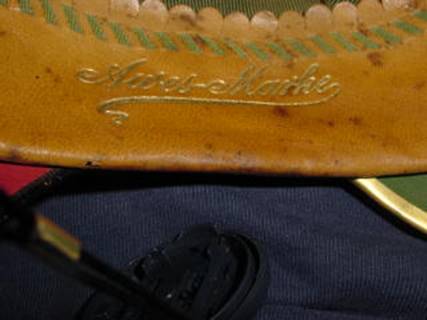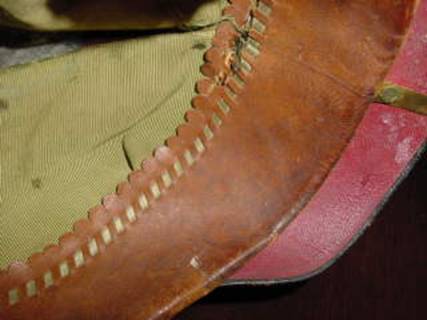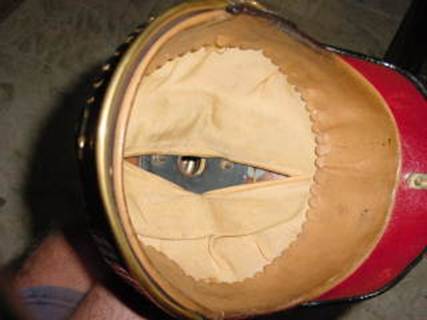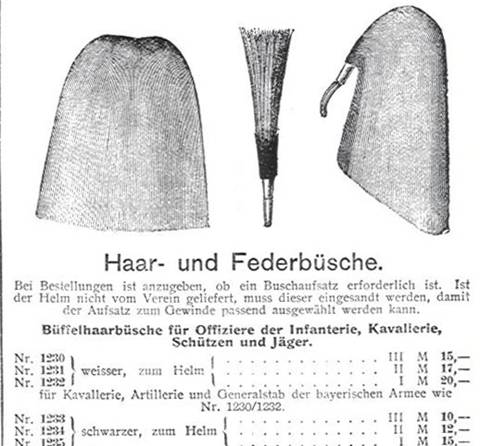The Relative Cost of a Pickelhaube
Joseph Robinson
Draft 2
25 April 2007 update
Bowman in Volume 1 pg 345-348 talks about period values of pickelhauben but offers no sources. He states that Lieutenants made 120 Marks a month and that a helmet was relatively expensive [i]. This intrigued me as I knew it was big industry to make Pickelhauben before WW1. Four generations of German soldiers had worn pickelhauben. [ii] Anecdotal evidence tells me 6% of the German economy was involved in Pickelhaube creation in some way. Bowman gives a much smaller number of 20,000 directly involved in production. [iii] I don’t recall Tuchman making anything of it in The Proud Tower but that is a huge part of the economy. Pickelhaubes were the common gift. Martin in his book gives the impression that a normal officer had 3 Pickelhaubes [iv]. He never came out and said it but the impression was one to wear walking out, one for normal duty, and one for parades. [v]
So I went off to find some data and determine how close Bowman was in his assertions.
The first thing I had to find was pay tables. This proved very difficult as the expected source Fuhrer durch Heer und Flotte [vi] had every possible pay table for travel, housing, and pensions but not the monthly pay. NCO and OR pay was in Das Kleine Buch von Deutschen Heere but not officers and it was dated 1901: too early for other evidence to match. Finally with the help of a German collector I found a source. [vii] While salaries varied by rank and longevity, here are a few samples:
F|r einen Hauptmann, Rittmeister, Stabarzt, Oberstabs- u. Stabsveterindr
- a) vom 1.-4. Jahre 283,33
- b) vom 5.-8. Jahre 383,33
- c) vom 9. Jahre ab 425
F|r einen Leutnant u. Oberleutnant
- a) vom 1.-3. Jahre 125
- b) vom 4.-6. Jahre 141,66
- c) vom 7.-9. Jahre 158,33
- d) vom 10.-12. Jahre 175
- e) vom 13. Jahre ab 200[viii]
So there it is. 125Marks per month in 1913 for a beginning officer. Remember I’m talking helmet costs now not total cost of living let alone equipping an officer. The Mark was about twenty cents and The US Lieutenant made $125 or 5 times the German Officer. [ix]
It is also instructive that NCOs and ORs made significantly less. [x] I point to the entry on Fähnriche to emphasize that these guys made little. Senior NCOs often had private purchase helmets. OYVs had to come fully equipped, so someone shelled out for them. It is curious to note that the Feldwebel in Life in a Garrison Townenriched himself by extorting money from the OYVs. Not only would he hit them as recruits but would accept payment annually during training, from some to lessen the severity of their duties. As a result he lived quite well and could afford fineries.
b.d. Fu_truppen b.d. berittenen Truppen
Gemeine 9,00 Marks 10,50
Gefreite 10,50 12,00
kapit. Gefr. 15,00 16,50
Fahrer wie f|r 15,60
Berittene, f|r
Hobisisten usw.
Fähnriche u. Unteroffiziere mit 25,20
weniger als 5 1/2 Dienstjahren
Sergeanten u. Unteroffiziere nach 39,60
5 1/2 jdhr. Dienszeit
Vizefeldwebel, Sergeanten u. 47,10
Unteroffiziere nach 9
jdhriger Dienstzeit
Feldwebel, Wachtmeister 62,10[xi]
The next step was to determine the cost of a helmet. For this I have four catalogs. The prices used for this article are from the Deutsche Officer Verein (DOV). The one I will use is dated April 1913. Tumhe other is an undated extract. [xii] Bowman alludes to another catalog in volume 1 but gives no source material. [xiii]
I’m not pricing uniforms or anything else. This is helmets only. The paucity of catalogs leads us to use a construct that is probably not universal . In the DOV catalog the first thing to notice is that all helmets have three levels you could buy at. I put them out as good, better, and best. As quality increased to did the cost. Lets look at an example of a line infantry helmet.
This construct of three levels is obviously not universal nor easy to show. However in the Neumann catalog and the Wunderlich catalog there are also three levels. There could easily be 10 levels with custom pieces etc. High value plate, low value leather etc. The only real way to determine is to have a catalog like DOV and three representative examples from the same year as the catalog. Each catalog differs. Each retailer claimed that his item was tremendously good. Differences in furniture is difficult to capture and even very nice plates suffer from 100 years of dirt, UV light, abrasive cleaners and who knows what. So it is very difficult to say: ‘This helmet is a low quality example. Some plates are better than others and as the war progressed the level of detail suffered. Part of this is a result of thin materials but it could also come from the wearing out of the dies. Helmet plates were die struck. So as the die wore out the plate would have less detail.
The uniform regulation of 1911 is very specific about sizes of fixtures. How big the chin scales had to be etc.[xv] There was nothing however, that differentiated the thickness of material. As the war went on all metal fixtures got thinner. Steel or zinc replaces brass prior to gilding. All of these were supply related and I have no evidence that it was price driven. As things became scarce I’m sure helmet price inflation kicked in but I have no data.
The one constant that you can compare on helmets is the quality of liner. Lots of gradient differences here so I will choose three distinct types for my construct.
BEST
It always seems that the maker Awes-Marke had really good helmets. Not all of the same quality, but the examples I have seen are a cut above. So our top grade example will have a premium liner with a tightening band through the leather and some embossing.
Better
Another Awes-Marke helmet, this one without the premium markings. Very fine helmet in all respects. This is my representative mid grade. At least I can compare two similar but not equal Saxon helmets. If you look at the picture in the DOV catalog under Zuschläge it shows a liner similar to this.
Good. The lowest of the three. Standard private purchase liner. The top cloth can run the gammut from cotton to silk and the underside of the visors run the gammut from painted paper to leather.
So there are three grades. There is much fault in this and of course anyone can take exception to it. These three are merely a construct. The Neumann catalog proved the existence of a Diensthelme or a service helmet. Diensthelme was a major type in the Wunderlich catalog. A Diensthelme is a privately purchased helmet for work or daily use. Without question the Diensthelme was the lowest quality and the least expensive. Both officers and one-year volunteers could use a Diensthelme to defray wear on the good helmets
OK so here we are a brand new Lieutenant of line infantry of a unit that had a busch and trichter. Our Sample LT we will put into Infantry Regiment 25. Lets buy a middle of the road helmet #1921 from the catalog. Looking pretty good and only down 19.50 Marks.
Ok so now a cover and other upgrades.
Cover 1120 =.70 Marks
Put my regiment # on the cover cost per digit 1124=.15Marks so =.45 Marks
Maneuver band.1125= .45 Marks
Put your name in it .1128 (Seldom used I don’t know why) =.40 Marks.
1116b offers Swiss leather liner with a rubber lining to absorb sweat and reduce pressure= 1Mark
1117 Seems to be a labor charge to change fittings for Infantry, Arty, or train. I don’t know how you avoid doing something. = 2 Marks
1118 Seems to be the same thing for a cruciform base and a much higher cost.
1119 makes it feather weight = 1 Mark
1120 is the white material in the skullcap. We will pass.
1121 A Liner…. got to have one =2 Marks
1124 Charge per letter to put your unit number in. I’ve only seen this once – we pass.
Armbands reserve crosses and names we can do without. But we have still added 8 Marks a total now of 27,5Marks[xvi]
Now comes the parade stuff. A Busch and Trichter. Again not all units had these really reducing the expense (16.1 Marks). It would not be a unit we would cherish to be in.
Three categories again. Notice how white is not only less common but also more expensive. We will go for top of the line black which costs the same as bottom of the line white. 15 Marks. Our total is now a whopping 42.5Marks. A couple of interesting points. One is the lack of standardization in the spike threads. This disclaimer clearly warns the buyer that if you didn’t buy the female end of the spike base from the DOV you had to leave the base to match up the threads. The second point of interest is how much cheaper horsehair trichters were. A third or less! Look at this table for Fähnriche.
Just when you thought you were done the box the Pickelhaube came in costs 10.25 Marks and the tube for the Haarbusch =1.10 Marks[xx] This adds 11.35 Marks to our original 42.5 for a total of 53.85 Marks.
So what does it mean? This was no small expense. No wonder they were common gifts given a 54 Mark price tag. Much to give. It was easy to add to our costs and elite units cost way more. If the new officer made 125Marks per month then 43% of a month’s salary. When you start adding in uniforms and horse furniture you needed another source of funds. There is little doubt that the debt load of a young officer without another source of income would be huge. The notorious book Life in a Garrison Town detailed the story of officers seeking loans and money constantly. While uniform costs were not singled out in that banned book, You can see how uniform costs could drive up total cost and one can understand how marriage became the financial salvation. DeBeers, diamond sellers and wedding planners today recommend the groom spend two month’s salary on an engagement ring. Pickelhaube were not that bad but if you needed three of them?
Did you need three of them? No. Especially as a One Year Volunteer (OYV) I doubt if you had three. But a line officer I cannot imagine having less than two. You could lose one or it could be damaged or wet. Wet leather helmets would be fun as Pickelhauben are not waterproof.
One of the most practical comments generated by an early draft of this article was that there must have been a thriving business in used Pickelhauben. You wouldn’t throw something that cost this much away. They also had a service at the DOV for rebuilding helmets on pg 40. Seems like a new one might be almost as cheap but for 15 Marks you could reclaim an old helmet. rebuilding and converting helmets was a major source of revenue for retailers. Conversions of old-style helmets, one-year volunteer helmets, and helmets for different regiments were made available through different sellers. Repairs were offered. This COULD explain a bunch of professionally plugged double holes. It also shows minor state helmets here. You could mail order a helmet so to speak.
[i] Bowman, J.A. The Pickelhaube Volume 1, Line Infantry, Imperial Publications, Lancaster, England, 1989, pg 345.
[ii] Bowman, J.A. The Pickelhaube Volume 2, Wartime, Ersatz,Reserve & artillery, Imperial Publications, Lancaster , England , 1992, pg 27.
[iii] Ibid.
[iv] Martin, A.G., Mother Country Fatherland, Macmillan & CO, London , 1936.
[v] Op cit, Bowman V2, pg 27.
[vi] Freidag, B. Fuhrer durch Heer und Flotte , Verlag J Olmes, Krefeld , Germany 1914.
[vii] Rabenau, von Die deutsche Land- und Seemacht und die Berufspflichten des Offiziers, Mittler u. Sohn, Berlin 1913 (Pg. 20-21)
[viii] Ibid.
[ix] Clemente, Stephen, For King and Kaiser, Greenwood Press, Westport , CT , 1992, pp. 161-162.
[x] Ibid.
[xi] ibid
[xii] Deutsche Officer Verein, Preislist 27, Armeehaus , Berlin , 1913.
[xiii] Op cit Bowman, Volume 1 pg 345.
[xiv] Ibid pg 25.
[xv] Behleidungs-Vorschrift für Offiziere und Sanitäts-Officecere des Königlich Preussischen Heeres , Berlin , 1911, Mittler & Sohn.
[xvi] Op Cit tDOV pg27
[xvii] Op cit DOV pg 27.
[xviii] Ibid. pg. 29
[xix] Ibid.
[xx] Ibis pg. 38

